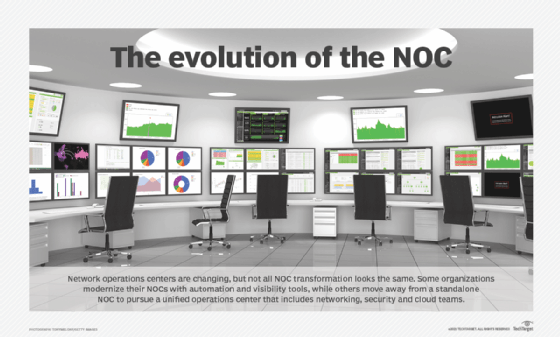Future of NOC transformation unifies IT teams
NOC transformation could lead to unified IT operations with cross-domain teams, but not all enterprises need radical change when smaller upgrades and modernization do the job.
In the technology world, it can be easy to throw around the word transformation and lose the nuances of what it entails.
Consider the networking industry. Remote work requires enterprises to rethink VPN strategies and management. Network automation means network practitioners have to shift from manual tasks and trust automated processes. Advances in security and visibility result in more collaboration with security teams. Like a chain reaction, each of these developments influences other areas, spurring more change, such as network operations center (NOC) transformation.
Transformation occurs in varying increments and levels, depending on enterprise strategies, risk and motivation -- and the same applies to NOCs. Some companies don't have -- or need -- NOCs, some are gradually modernizing their NOCs and some are pursuing full-blown NOC transformation.
The role of traditional NOCs
For years, organizations have used NOCs to maintain an operational view of the network and the services running across it. NOC technicians and analysts follow certain best practices to monitor network performance, handle service desk tickets, triage and troubleshoot, and, if needed, escalate problems.
But many businesses don't function the same way they did five years ago -- or even one year ago -- and various factors are reshaping network operations strategies and priorities. The global pandemic is one obvious stimulant. But progress in server virtualization, IoT, cloud, containers and microservices has also sparked NOC transformation, said Shamus McGillicuddy, vice president of network management research at Enterprise Management Associates.
As technology has evolved, network traffic flows have changed, and application support is more complicated. As a result, network operations need to be more proactive and implement comprehensive visibility tools for their environments.
For example, according to McGillicuddy, end users recognize one-third of all IT service problems before NOC technicians or other teams are alerted, which means one-third of all problems can impede business productivity before IT is aware of them. Remote work has exacerbated many of those management concerns, prompting network technicians to retool so they can achieve visibility into home office networks. Those tools include remote desktop access, endpoint transaction monitoring and laptop agents that generate test traffic to gauge latency and dropped packets, he said.
Brad Casemore, research vice president of data center and multi-cloud networks at IDC, also sees the need for more proactive operations. As operating models change, network teams should shift from tactical tasks -- in which they simply deploy, fix and maintain operations -- to strategic tasks that enable innovation and automation, Casemore said during a webinar on the future of enterprise networking.

Virtualization and automation drive NOC modernization
Many NOC upgrades aren't radical transformations; rather, they're part of business strategies to virtualize, consolidate or modernize networks. Network teams undertake these upgrades to meet their goals of reduced downtime, improved end-user satisfaction and increased innovation within IT, McGillicuddy said.
Within networking, McGillicuddy said teams are prioritizing modernization in the following areas:
- network security
- network virtualization
- network automation
- network operations optimization
With network operations optimization, teams look at how they can improve service-level agreement compliance and accelerate their mean time to resolution, he said. In some cases, NOC teams troubleshoot issues that are originally perceived to be network problems, which they later discover to be security incidents. That time lapse could be critical in the event of a breach or attack -- and could be shortened if network teams worked with security teams.
"Over the last four or five years, network operations teams -- whether they're in a NOC or a cross-domain team -- are trying to work more closely with security," McGillicuddy said.
Casemore has also seen enterprises shift their network operations strategies to prioritize integrated network and security management, noting how networking and security are "increasingly bonded." As the integration of the two previously siloed departments strengthens, so too does IT innovation.
NOC transformation with unified operations
Enterprises that are focused on IT innovation and optimizing network operations could pursue a more transformational operations strategy. Perhaps the most ambitious NOC transformation is one that eliminates the standalone NOC and security operations center in favor of a unified operations center that includes networking, security, cloud and applications teams, McGillicuddy said.
The goal of this unified approach is to streamline operations so all applications and services are highly resilient and avoid long downtimes, he said. Cross-domain teams collaborate to prevent trouble proactively instead of reacting to issues, helping enterprises achieve the innovation they desire.
Operations teams, however, need IT leadership guidance if they want to implement a unified operations approach. Different teams might not always get along, but the initiative is more likely to succeed with leadership support, McGillicuddy said.
Another important factor to consider is data, which could be an asset or obstacle to a unified IT operations approach.
"[Networking and security] might have their own data repositories they guard jealously and don't want to share. If they do share, they might find their data conflicts with each other," McGillicuddy said.
A way to address that issue is to have a common data set. Enterprises can implement a fabric that centrally distributes traffic to the individual tools each team uses. Those tools glean data from the same fabric, so teams can collaborate better and share data. The teams can also share an analysis tool -- with clear processes on how to use it -- to provide common views, reports and dashboards.
NOC transformation not for everyone
Moving away from a standalone NOC to a unified operations approach can help streamline IT operations and improve overall service delivery, McGillicuddy said. But independent NOCs are still an established and reliable way to monitor operations -- and moving away from them is a disruptive strategy that might not be for every organization.
"NOC transformation isn't going to be for everyone, and it isn't necessarily a best practice to go from a traditional NOC to something like an integrated cross-domain operation center," he said.







